Sapropel as a Binding Material for Wood Processing Waste in the Development of Thermal Insulation Biocomposite
Abstract
1. Introduction
2. Materials and Methods
2.1. Materials
2.2. Preparation of Specimens
2.3. Tests Metods
3. Results and Discussion
3.1. Sapropel
3.2. Wood Waste
3.3. Thermal Conductivity and Compressive Stress of Biocomposite
3.4. Structure of Biocomposite
4. Conclusions
Author Contributions
Funding
Institutional Review Board Statement
Informed Consent Statement
Data Availability Statement
Conflicts of Interest
References
- Liu, Y.; Li, K. Development and characterization of adhesives from soy protein for bonding wood. Int. J. Adhes. Adhes. 2007, 27, 59–67. [Google Scholar] [CrossRef]
- Huang, S.; Song, S.; Nielsen, C.P.; Zhang, Y.; Xiong, J.; Weschler, L.B.; Xie, S.; Li, J. Residential building materials: An important source of ambient formaldehyde in mainland China. Environ. Int. 2022, 158, 106909. [Google Scholar] [CrossRef] [PubMed]
- Kwak, K.; Paek, D.; Park, J.T. Occupational exposure to formaldehyde and risk of lung cancer: A systematic review and meta-analysis. Am. J. Ind. Med. 2020, 63, 312–327. [Google Scholar] [CrossRef]
- Duong, A.; Steinmaus, C.; McHale, C.M.; Vaughan, C.P.; Zhang, L. Reproductive and developmental toxicity of formaldehyde: A systematic review. Mutat. Res. Rev. Mutat. Res. 2011, 728, 118–138. [Google Scholar] [CrossRef]
- Soltanpour, Z.; Mohammadian, Y.; Fakhri, Y. The exposure to formaldehyde in industries and health care centers: A systematic review and probabilistic health risk assessment. Environ. Res. 2022, 204, 112094. [Google Scholar] [CrossRef]
- Huang, L.; Fantke, P.; Ritscher, A.; Jolliet, O. Chemicals of concern in building materials: A high-throughput screening. J. Hazard. Mater. 2022, 424, 127574. [Google Scholar] [CrossRef]
- Mohamad, N.; Muthusamy, K.; Embong, R.; Kusbiantoro, A.; Hashim, M.H. Environmental impact of cement production and Solutions: A review. Mater. Today Proc. 2022, 48, 741–746. [Google Scholar] [CrossRef]
- Galusnyak, S.C.; Petrescu, L.; Cormos, C.C. Environmental impact assessment of post-combustion CO2 capture technologies applied to cement production plants. J. Environ. Manag. 2022, 320, 115908. [Google Scholar] [CrossRef]
- Belbute, J.M.; Pereira, A.M. Reference forecasts for CO2 emissions from fossil-fuel combustion and cement production in Portugal. Energy Policy 2020, 144, 111642. [Google Scholar] [CrossRef] [PubMed]
- Fava, F.; Totaro, G.; Diels, L.; Reis, M.; Duarte, J.; Carioca, O.B.; Ferreira, B.S. Biowaste biorefinery in Europe: Opportunities and research & development needs. New Biotechnol. 2015, 32, 100–108. [Google Scholar] [CrossRef]
- Ren, J.; Du, G.; Liu, S.; Yang, H.; Ran, X.; Liu, C.; Liu, T.; Li, Z.; Zhou, X.; Gao, W.; et al. High-strength, self-initiated, wide pH range of underwater adhesive suitable for different severe environments. J. Chem. Eng. 2023, 455, 140640. [Google Scholar] [CrossRef]
- Zheng, L.; Zuo, Y.; Li, X.; Wu, Y. Biomimetic Swallow Nest Structure: A Lightweight and High-Strength Thermal Insulation Material. ACS Nano 2022, 16, 8116–8127. [Google Scholar] [CrossRef]
- Liu, T.; Du, G.; Wu, Y.; Liu, C.; Yang, H.; Ni, K.; Yin, C.; Ran, X.; Gao, W.; Yang, L. Activated wood surface and functionalized cellulose co-building strong chemical wood bonding performance. Carbohydr. Polym. 2023, 305, 120573. [Google Scholar] [CrossRef] [PubMed]
- Balčiūnas, G.; Žvironaitė, J.; Vėjelis, S.; Jagniatinskis, A.; Gaiducis, S. Ecological, thermal and acoustical insulating composite from hemp shives and sapropel binder. Ind. Crop. Prod. 2016, 91, 286–294. [Google Scholar] [CrossRef]
- Obuka, V.; Šinka, M.; Kļaviņš, M.; Stankeviča, K.; Korjakins, A. Sapropel as a Binder: Properties and Application Possibilities for Composite Materials. In Proceedings of the 2nd International Conference on Innovative Materials, Structures and Technologies, Riga, Latvia, 30 September–2 October 2015. [Google Scholar] [CrossRef]
- Brencis, R.; Pleiksnis, S.; Skujans, J.; Adamovics, A.; Gross, U. Lightweight Composite Building Materials with Hemp (Cannabis sativa L.). Chem. Eng. Trans. 2017, 57, 1375–1380. [Google Scholar] [CrossRef]
- Stankevica, K.; Vincevica-Gaile, Z.; Klavins, M. Freshwater sapropel (gyttja): Its description, properties and opportunities of use in contemporary agriculture. Agron. Res. 2016, 14, 929–947. [Google Scholar]
- Daugvilienė, D.; Inovatyvios technologijos sapropeliui perdirbti į trąšas ar dirvožemio gerinimo medžiagą sukūrimas ir šios technologijos praktinis pritaikymas. Ataskaita. 2014. Available online: https://zum.lrv.lt/uploads/zum/documents/files/LT_versija/Veiklos_sritys/Mokslas_mokymas_ir_konsultavimas/Moksliniu_tyrimu_ir_taikomosios_veiklos_darbu_galutines_ataskaitos/Sapropelis.pdf (accessed on 18 September 2022).
- Obuka, V. Sapropel for the Development of Biocomposite Materials: Properties and Application Possibilities. Doctoral Thesis, University of Latvia, Riga, Latvia, 2021. [Google Scholar]
- Kozlovska, J. Research of Sapropel Use for Heat Production and Environmental Assessment. Summary of Doctoral Dissertation; Technika: Vilnius, Lithuania, 2012; p. 24. [Google Scholar]
- Steponavičius, P.; Svitojus, A.; Bakšienė, E.; Daugvilienė, D. Organic Fertilizers Based on Sapropel and Their Production Method. WO2012/055379A1, 3 May 2012. [Google Scholar]
- Žvironaitė, J.; Ciūnys, A.; Gerdžiūnas, P. Ežerų valymo produkto—Sapropelio panaudojimo galimybių tyrimai. Aplinkos Inžinerija 2002, 10, 168–175. [Google Scholar]
- Bogush, A.A.; Leonova, G.A.; Krivonogov, S.K.; Bychinsky, V.A.; Bobrov, V.A.; Maltsev, A.E.; Tikhova, V.D.; Miroshnichenko, L.V.; Kondratyeva, L.M.; Kuzmina, A.E. Biogeochemistry and element speciation in sapropel from freshwater Lake Dukhovoe (East Baikal region, Russia). Appl. Geochem. 2022, 143, 105384. [Google Scholar] [CrossRef]
- Krivonos, O.I.; Terekhova, E.N.; Belskaya, O.B. Catalytic hydroprocessing of organic matter of sapropels. The effects of sapropel nature on the yield and composition of products. Catal. Today 2021, 378, 126–132. [Google Scholar] [CrossRef]
- Obuka, V.; Sinka, M.; Nikolajeva, V.; Kostjukova, S.; Ozola-Davidane, R.; Klavins, M. Microbiological Stability of Bio-Based Building Materials. J. Ecol. Eng. 2021, 22, 296–313. [Google Scholar] [CrossRef]
- Balčiūnas, G. Investigation of Building Composites with Fibre Hemp Shives. Doctoral Dissertation, Technika, Vilnius, Lithuania, 2015; p. 134. [Google Scholar]
- EN ISO 12570; Hygrothermal Performance of Building Materials and Products—Determination of Moisture Content by Drying at Elevated Temperature. European Committee for Standardization: Brussels, Belgium, 2000.
- EN 13820; Thermal Insulating Materials for Building Applications—Determination of Organic Content. European Committee for Standardization: Brussels, Belgium, 2003.
- EN 1607; Thermal Insulating Products for Building Applications—Determination of Tensile Strength Perpendicular to Faces. European Committee for Standardization: Brussels, Belgium, 2013.
- EN 12667; Thermal Performance of Building Materials and Products—Determination of Thermal Resistance by Means of Guarded Hot Plate and Heat Flow Meter Methods—Products of High and Medium Thermal Resistance. European Committee for Standardization: Brussels, Belgium, 2001.
- EN 826; Thermal Insulating Products for Building Applications—Determination of Compression Behaviour. European Committee for Standardization: Brussels, Belgium, 2013.
- Fricke, J. Physical Aspects of Heat Transfer and the Development of Thermal Insulations. In Proceedings of the International Conference and Workshop, EMPA, Duebendorf, Switzerland, 22–24 January 2001. [Google Scholar]
- Augaitis, N.; Vaitkus, S.; Członka, S.; Kairytė, A. Research of Wood Waste as a Potential Filler for Loose-Fill Building Insulation: Appropriate Selection and Incorporation into Polyurethane Biocomposite Foams. Materials 2020, 13, 5336. [Google Scholar] [CrossRef] [PubMed]
- Pundiene, I.; Vitola, L.; Pranckeviciene, J.; Bajare, D. Hemp Shive-Based Bio-Composites Bounded by Potato Starch Binder: The Roles of Aggregate Particle Size and Aspect Ratio. J. Ecol. Eng. 2022, 23, 220–234. [Google Scholar] [CrossRef]
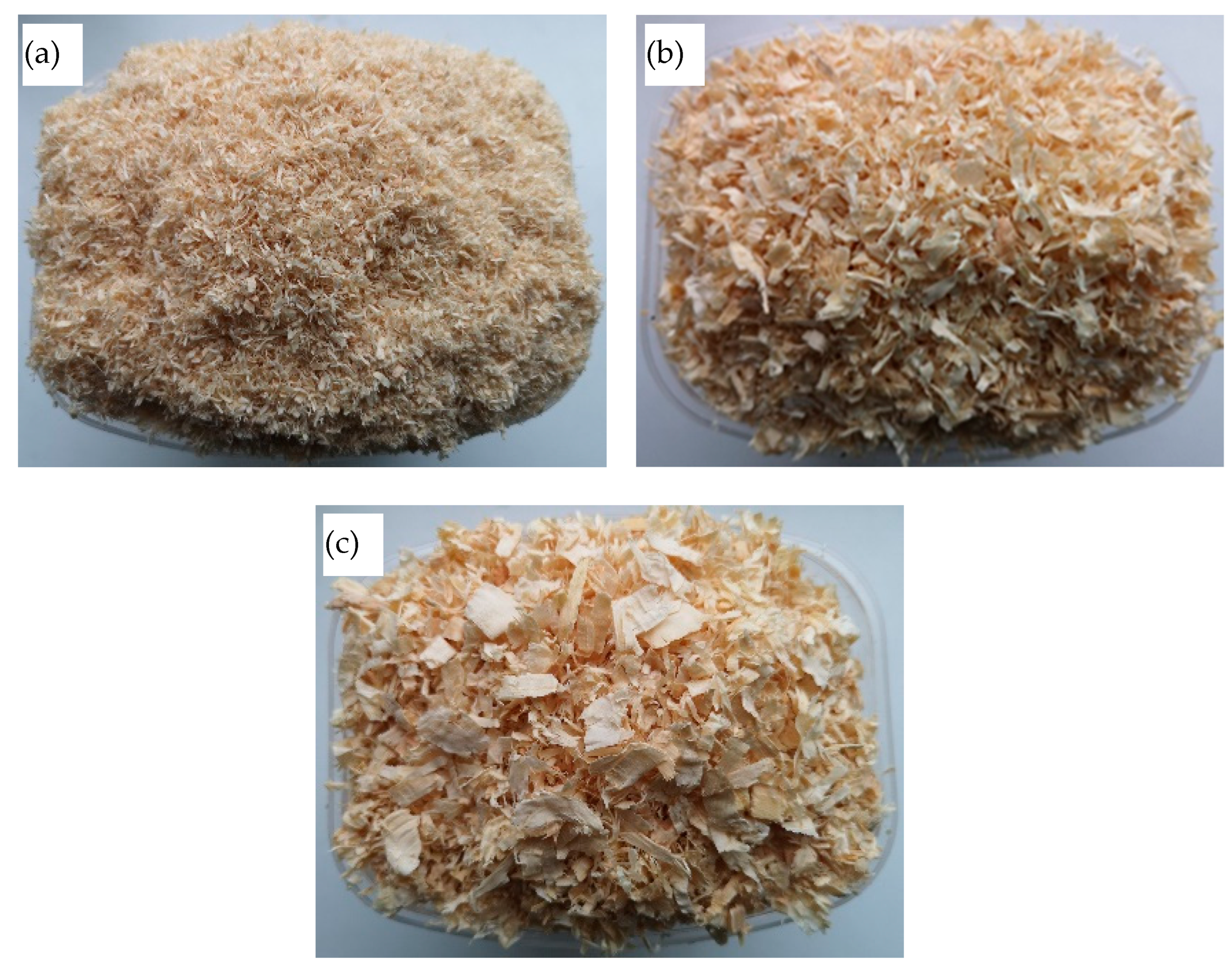
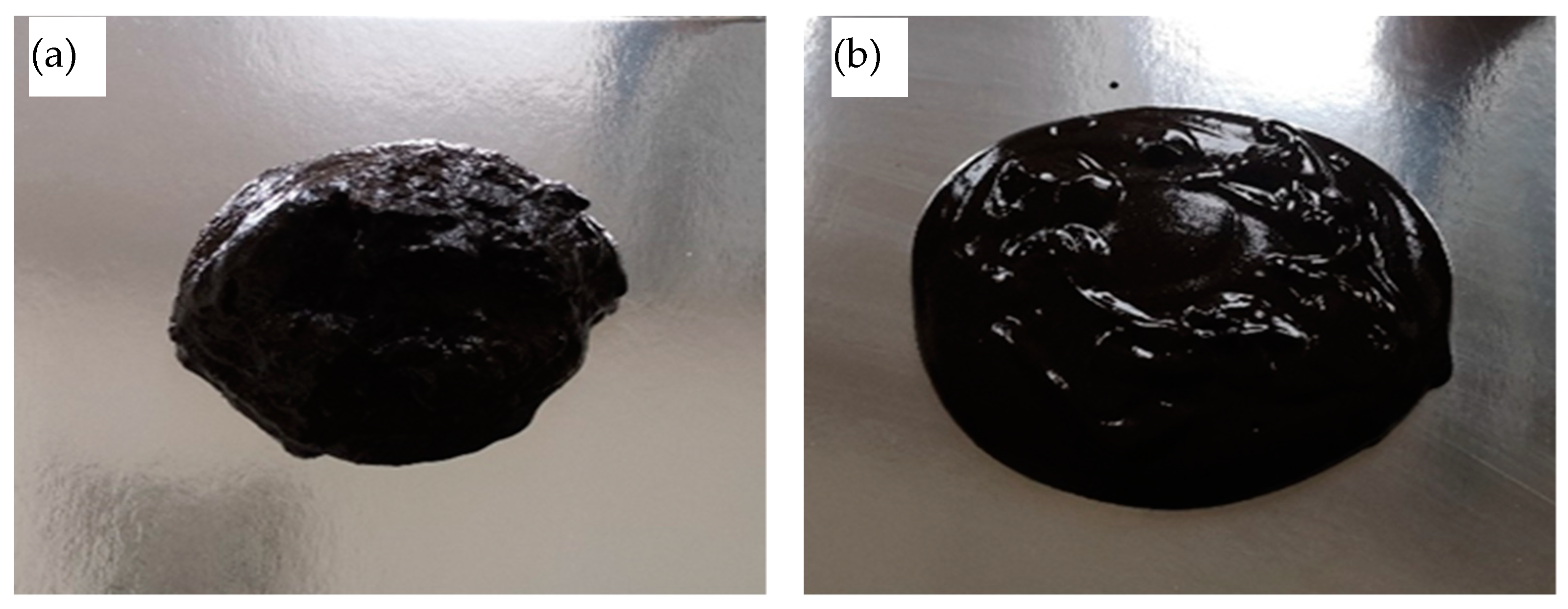
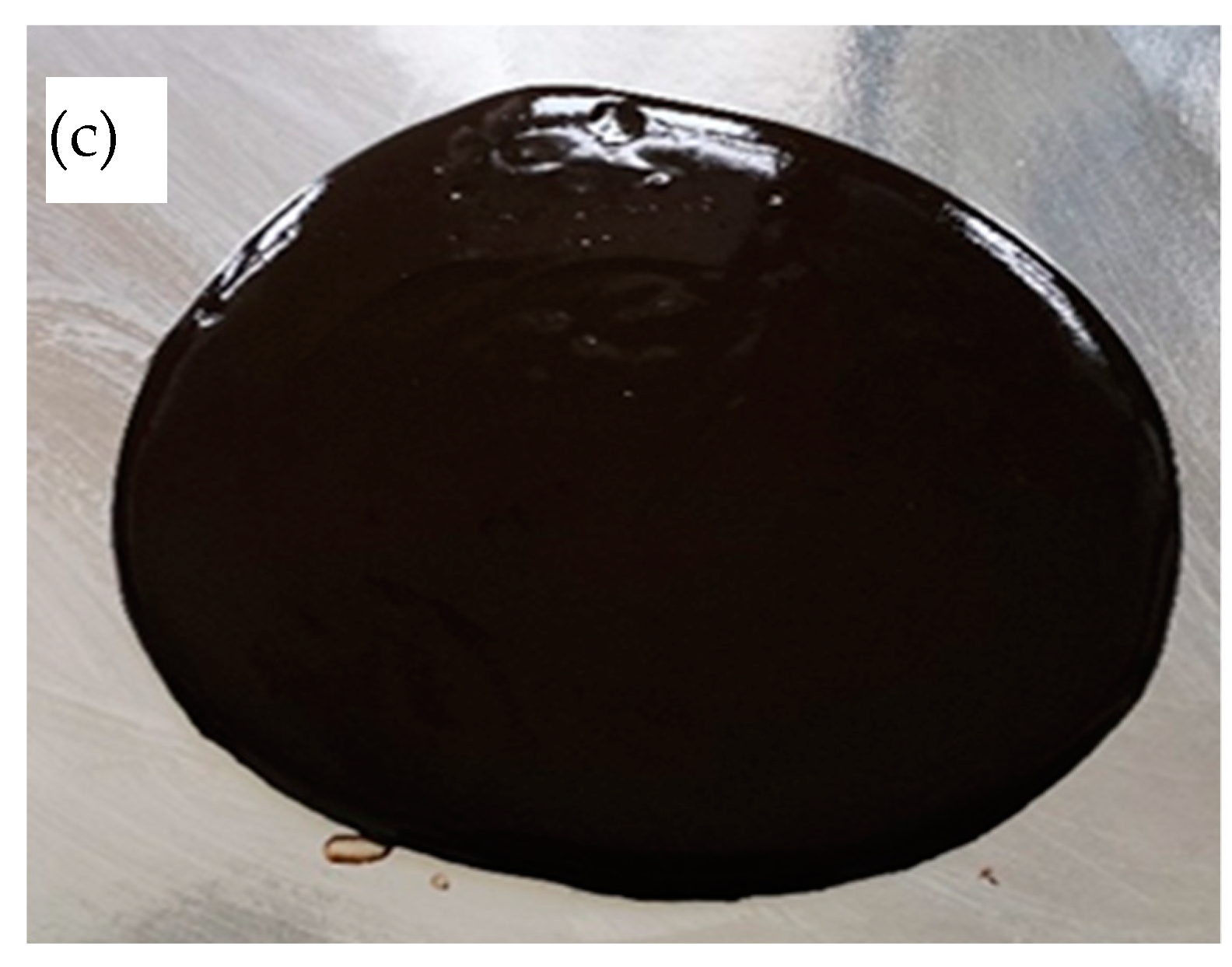
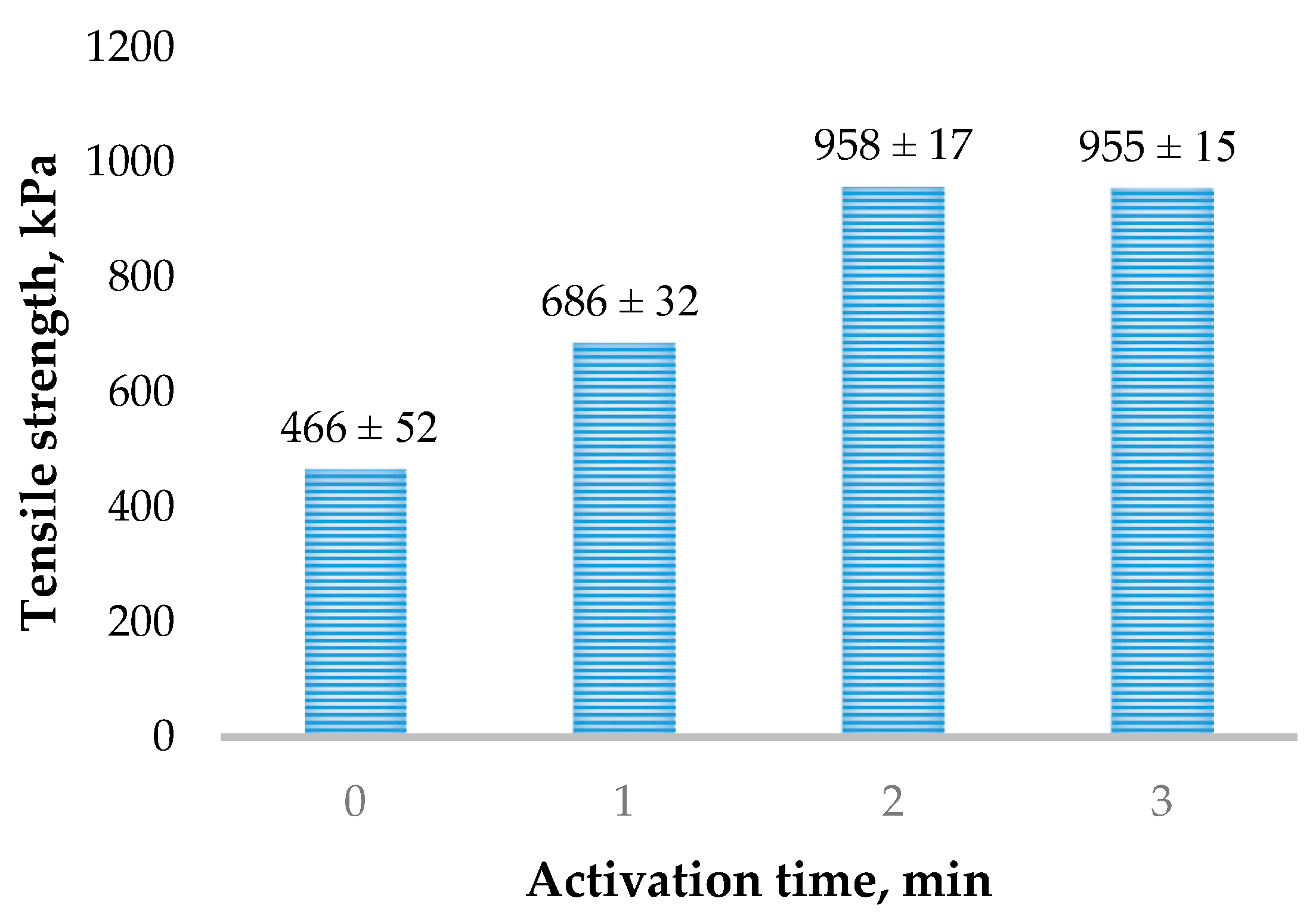
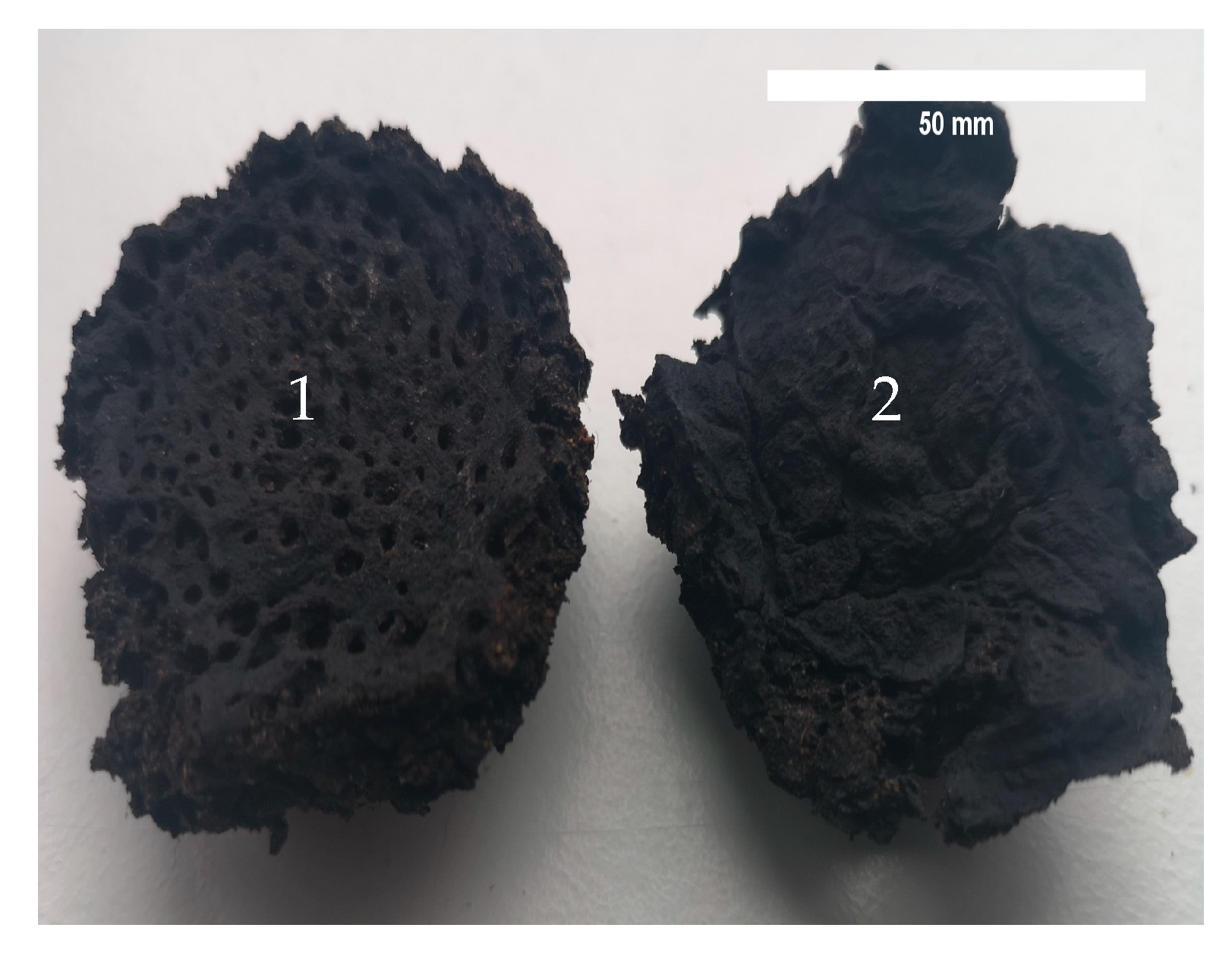
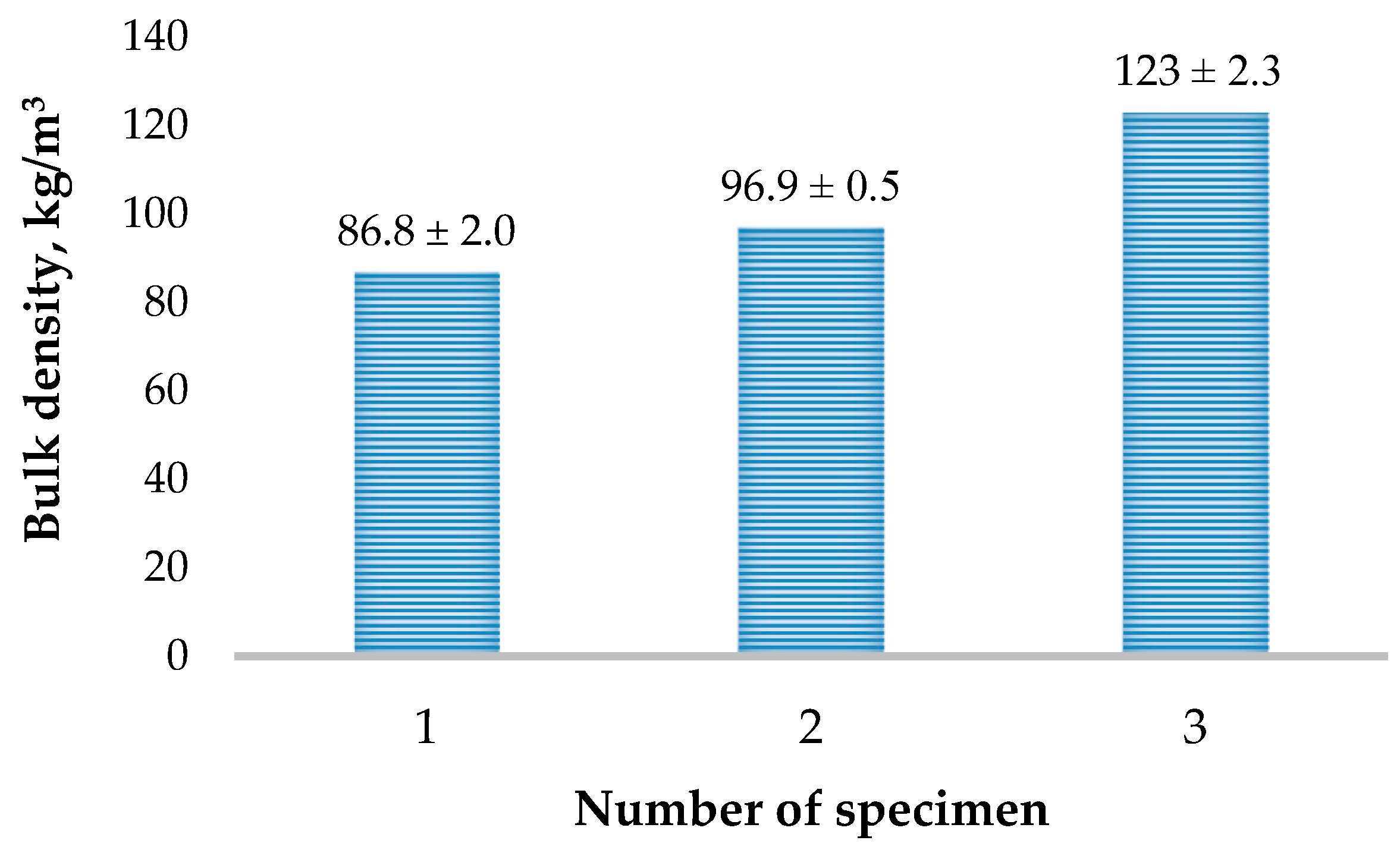
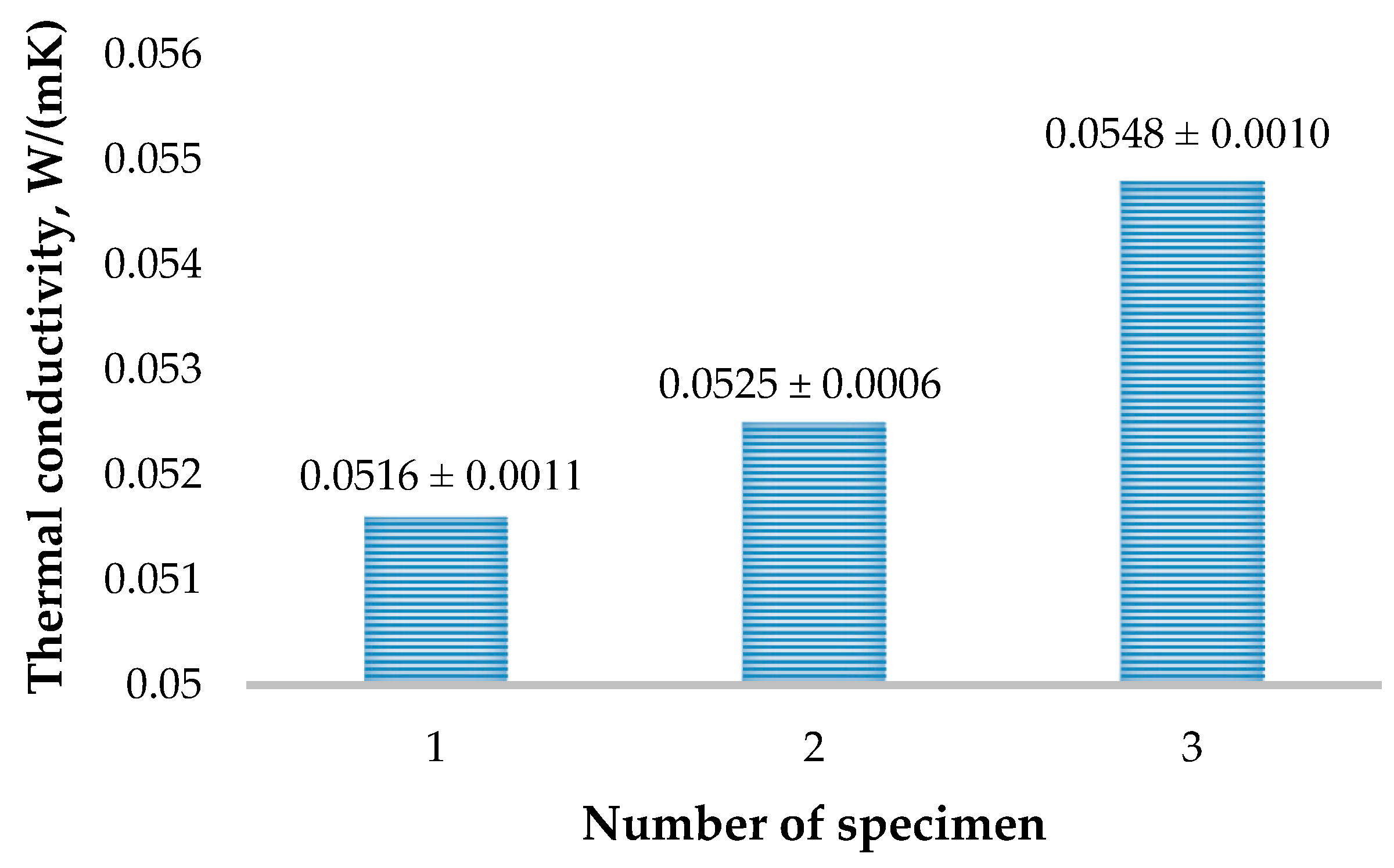
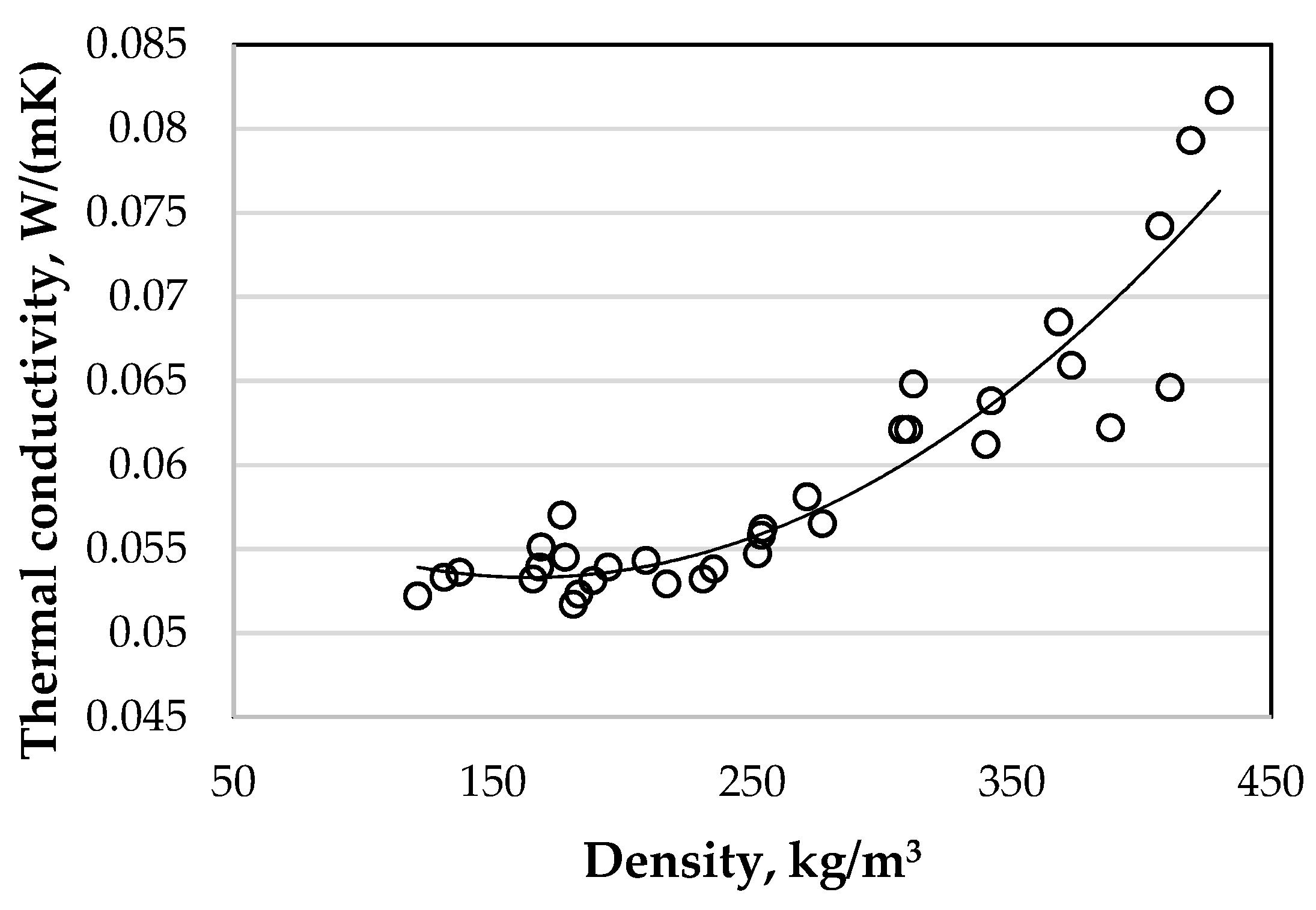
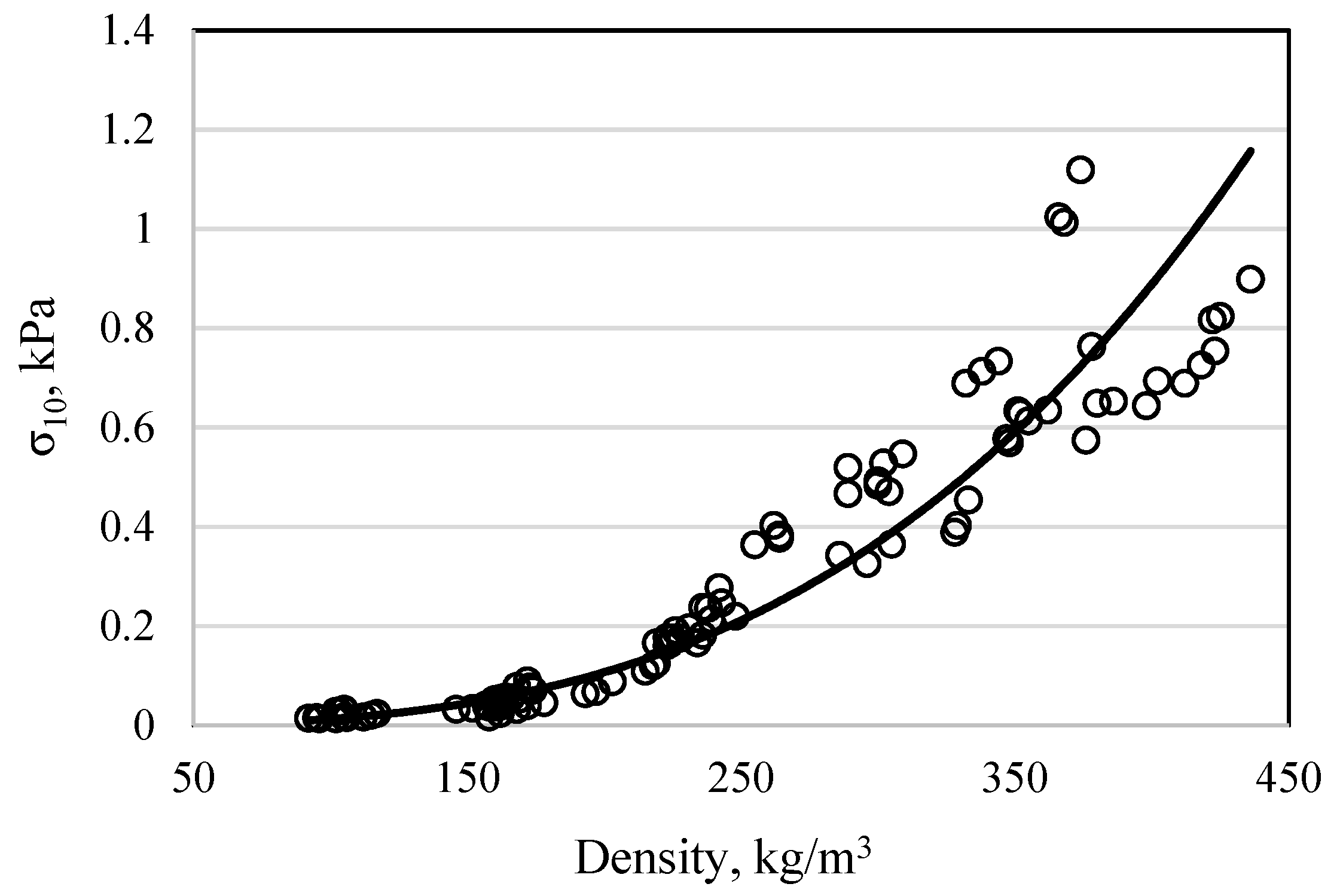
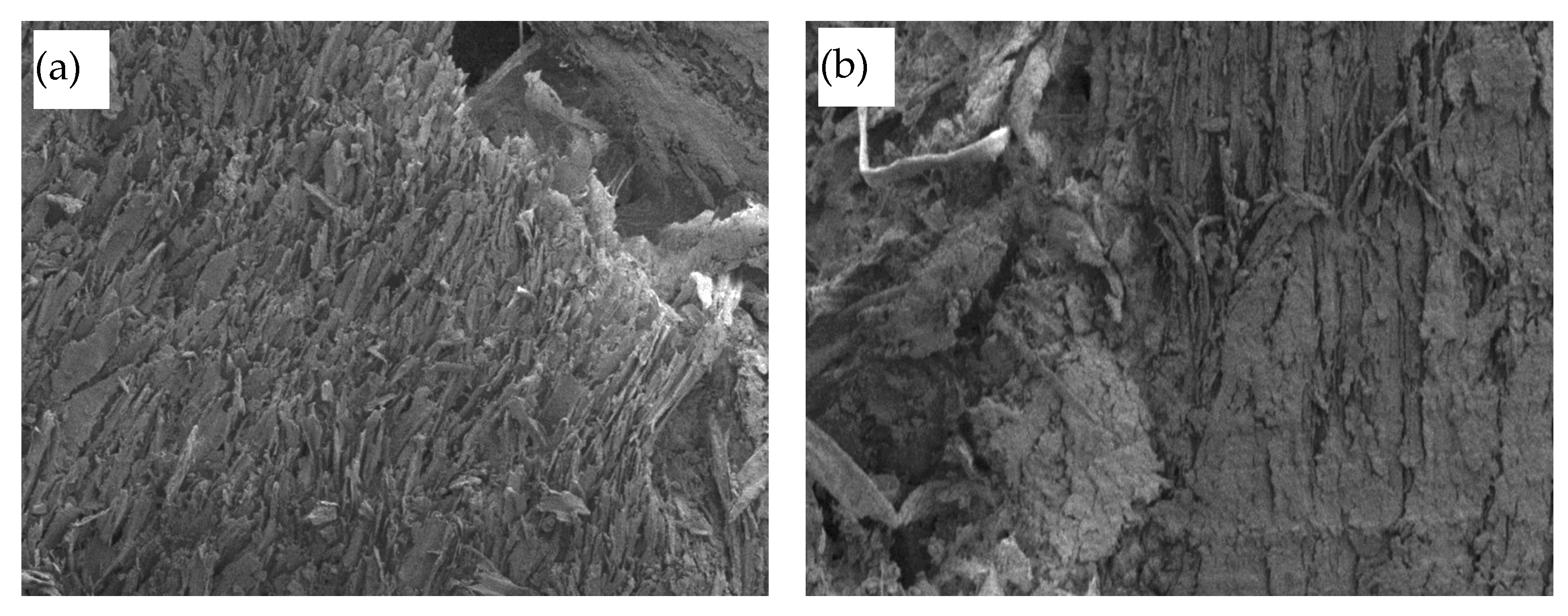
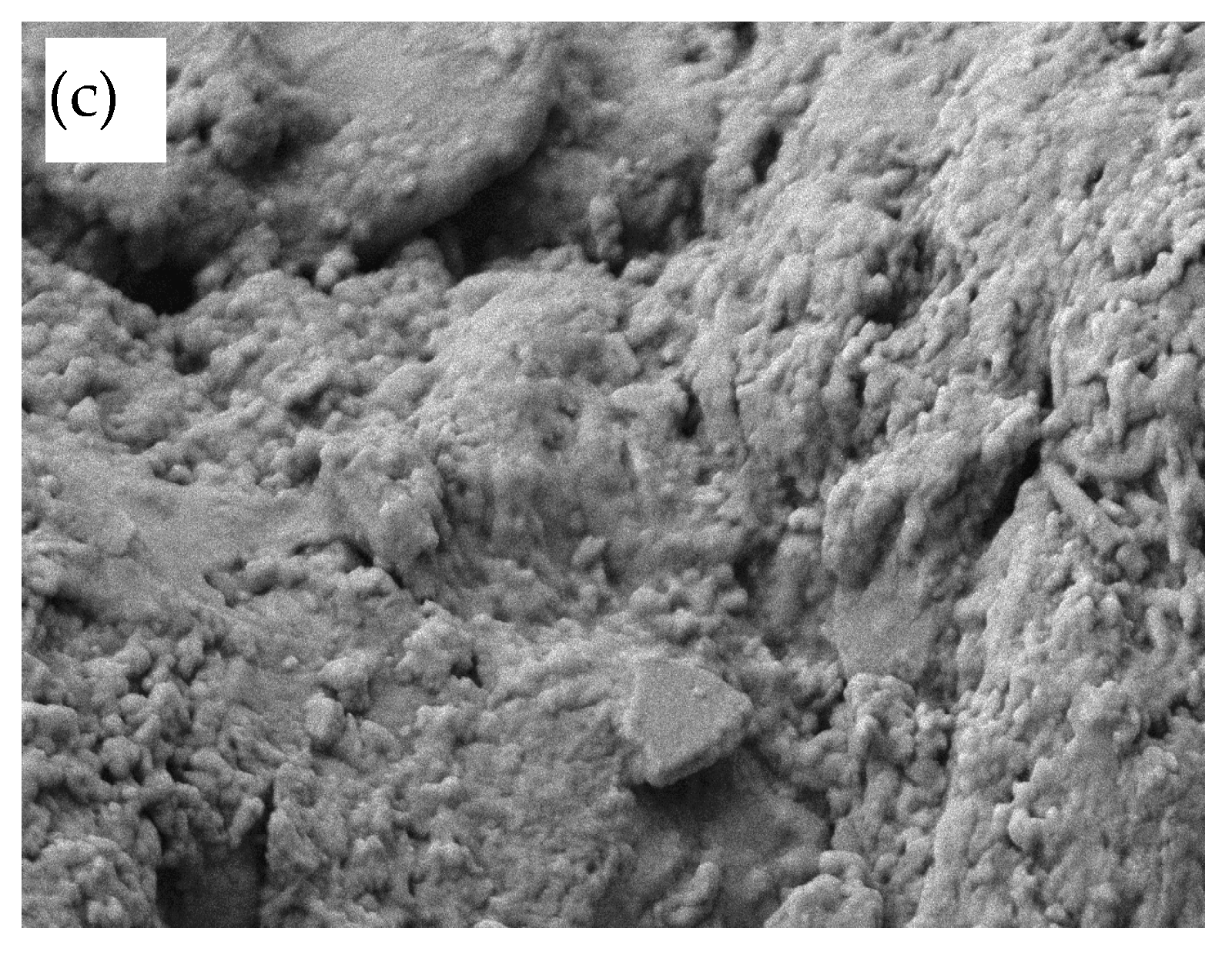
| Place of Sampling Sapropel | Water Content, Mass % | Content of Organic Matter, Mass % |
|---|---|---|
| Lake Kerėplis, the district of Trakai, Lithuania | 93.1 | 95.8 |
| Mesh Size of Mill Sieves, mm | Residue of Wood Waste Particles on Sieves, % | ||||||
|---|---|---|---|---|---|---|---|
| Sieve Mesh Size, mm | |||||||
| 10 | 5 | 2.5 | 1.25 | 0.63 | 0.315 | 0 | |
| 20 | 1.5 | 38.8 | 50.8 | 3.0 | 4.3 | 1.3 | 0.3 |
| 10 | 0 | 14.7 | 67.6 | 7.0 | 7.7 | 2.0 | 1.0 |
| 5 | 0 | 0 | 38.0 | 14.7 | 31.7 | 11.3 | 4.3 |
| Mixture No. | Fraction of Used Wood Waste, mm | Content of Sapropel, %, from the Mass of Wood Waste | Compression Level, % of the Height of the Initial Mass of the Mixture |
|---|---|---|---|
| 1-1 | 0–5 | 4 | 20 |
| 1-2 | 8 | ||
| 1-3 | 12 | ||
| 1-4 | 4 | 40 | |
| 1-5 | 8 | ||
| 1-6 | 12 | ||
| 1-7 | 4 | 60 | |
| 1-8 | 8 | ||
| 1-9 | 12 | ||
| 1-10 | 4 | 80 | |
| 1-11 | 8 | ||
| 1-12 | 12 | ||
| 2-1 | 0–10 | 4 | 20 |
| 2-2 | 8 | ||
| 2-3 | 12 | ||
| 2-4 | 4 | 40 | |
| 2-5 | 8 | ||
| 2-6 | 12 | ||
| 2-7 | 4 | 60 | |
| 2-8 | 8 | ||
| 2-9 | 12 | ||
| 2-10 | 4 | 80 | |
| 2-11 | 8 | ||
| 2-12 | 12 | ||
| 3-1 | 0–20 | 4 | 20 |
| 3-2 | 8 | ||
| 3-3 | 12 | ||
| 3-4 | 4 | 40 | |
| 3-5 | 8 | ||
| 3-6 | 12 | ||
| 3-7 | 4 | 60 | |
| 3-8 | 8 | ||
| 3-9 | 12 | ||
| 3-10 | 4 | 80 | |
| 3-11 | 8 | ||
| 3-12 | 12 |
| Number of Test Specimen | Activation Time, min | Consistency, mm |
|---|---|---|
| 1 | 0 | 112 |
| 2 | 1 | 152 |
| 3 | 2 | 167 |
| 4 | 3 | 168 |
Disclaimer/Publisher’s Note: The statements, opinions and data contained in all publications are solely those of the individual author(s) and contributor(s) and not of MDPI and/or the editor(s). MDPI and/or the editor(s) disclaim responsibility for any injury to people or property resulting from any ideas, methods, instructions or products referred to in the content. |
© 2023 by the authors. Licensee MDPI, Basel, Switzerland. This article is an open access article distributed under the terms and conditions of the Creative Commons Attribution (CC BY) license (https://creativecommons.org/licenses/by/4.0/).
Share and Cite
Vėjelis, S.; Karimova, M.B.; Kuatbayeva, T.K.; Kairytė, A.; Šeputytė-Jucikė, J. Sapropel as a Binding Material for Wood Processing Waste in the Development of Thermal Insulation Biocomposite. Materials 2023, 16, 2230. https://doi.org/10.3390/ma16062230
Vėjelis S, Karimova MB, Kuatbayeva TK, Kairytė A, Šeputytė-Jucikė J. Sapropel as a Binding Material for Wood Processing Waste in the Development of Thermal Insulation Biocomposite. Materials. 2023; 16(6):2230. https://doi.org/10.3390/ma16062230
Chicago/Turabian StyleVėjelis, Sigitas, Meruert Bolatkyzy Karimova, Tokzhan Kuangalyevna Kuatbayeva, Agnė Kairytė, and Jurga Šeputytė-Jucikė. 2023. "Sapropel as a Binding Material for Wood Processing Waste in the Development of Thermal Insulation Biocomposite" Materials 16, no. 6: 2230. https://doi.org/10.3390/ma16062230
APA StyleVėjelis, S., Karimova, M. B., Kuatbayeva, T. K., Kairytė, A., & Šeputytė-Jucikė, J. (2023). Sapropel as a Binding Material for Wood Processing Waste in the Development of Thermal Insulation Biocomposite. Materials, 16(6), 2230. https://doi.org/10.3390/ma16062230







